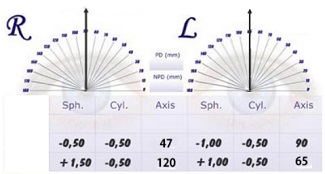what is hyperopia
Light of Class 8
DEFECTS OF VISION AND THEIR CORRECTION
People with normal vision can focus clearly on very distant objects. We say their far point is at infinity.
People with normal vision can also focus clearly on near objects upto a distance of 25 cm. We say their near point is at a distance of 25 cm from the eye.
But there are some defects due to eye irregularities which are as follows :
SHORT SIGHTEDNESS (OR MYOPIA) :
Nearsightedness or myopia refers to an eye that can only focus on objects that are close. Distant objects are not seen clearly (i.e. the far point is not infinity). It can be caused by an eyeball that is too long or a cornea that has too much curvature. It is corrected by a diverging lens (concave)
A person who can see the near objects clearly but cannot focus on distant objects in short sightedness. The far point of a short-sighted person may be only a few metres rather than at infinity. This defect occurs if a person's eyeball is larger than the usual diameter. In such a case, the image of a distant object is formed in front of the retina as shown in the figure. It is because the eye lens remains too converging, forming the image of the object in front of the retina.
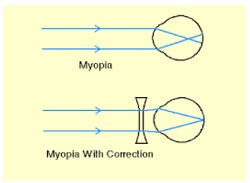
To correct short-sighted vision, a diverging lens (concave lens) of suitable focal length is placed in front of the eye as shown in figure. The rays of light from distant object are diverged by the concave lens so that final image is formed at the retina. If the object is very far off , then focal length of the concave lens is so chosen that virtual image of the distant object is formed at the far point F of the short-sighted eye. Therefore rays of light appear to come from the image at the far point F of the short-sighted eye and not from the more distant object.
Note that focal length of the lens for a short-sighted person is equal to the negative value of the person's far point.
NCERT solutions for class 8 Science prepared by Physics Wallah will help you to solve your NCERT text book exercise.
FAR SIGHTEDNESS (OR HYPEROPIA OR HYPERMETROPIA):
Farsightedness or hypermetropia refers to an eye that can only focus on objects that are at a distance. Close objects are not seen clearly (i.e. the near point is somewhat greater than the "normal" 25 cm). It can be caused by an eyeball that is too short or a cornea that has too little curvature It is corrected by a converging lens (convex).
A person who can see distant objects clearly but cannot focus on near objects is farsighted, whereas the normal eye has a near point of about 25 cm. A farsighted person may have a near point several metres from the eye. This defect may occur if the diameter of person's eyeball is smaller than the usual or if the lens of the eye is unable to curve when ciliary muscle contract. In such a case, for an object placed at the normal near point (i.e. 25 cm from eye), the image of the object is formed behind the retina as shown in the figure (i). It is because the lens of the eye is not sufficiently converging to focus the object located at the normal near point.
A farsighted person has the normal far point but needs a converging lens in order to focus objects which are as close as 25 cm. The converging lens of correct focal length will cause the virtual image to be formed at the actual near point of the farsighted person's eye as shown in figure.
Sight Correction Diagrams
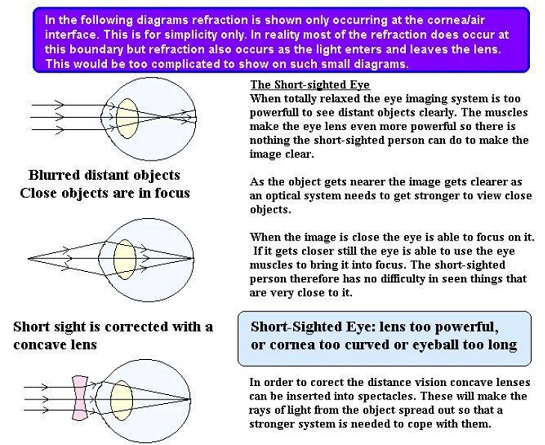
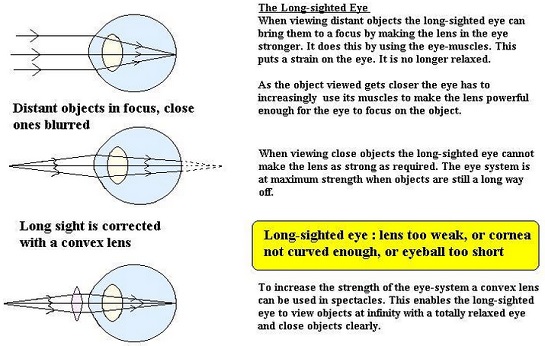
PRESBYOPIA:
This defects arises with aging. A person suffering from this defect can see neither nearby objects nor distant objects clearly/distinctly. This is because the power of accommodation of the eye decreases due to the gradual weakening of the ciliary muscles and diminishing flexibility of the eye lens.
This defect can be corrected by using bi-focal lenses. Its lower part consists of a convex lens and is used for reading purposes whereas the upper part consists of a concave lens and is used for seeing distant objects.
ASTIGMATISM:
A person suffering from the defect cannot simultaneously focus on both horizontal and vertical lines of a wire gauze.
This defect arises due to the fact that the cornea is not perfectly spherical and has different curvatures for horizontally and vertically lying objects. Hence, objects in one direction are well focused whereas objects in the perpendicular direction are not well focused.
Astigmatism is quite common. It causes difficulties in seeing fine detail. It is particularly noticeable when people suffering from it view text. Studies have shown that about one in three people suffers from it. The prevalence of astigmatism increases with age. Although a person may not notice mild astigmatism, higher amounts of astigmatism may cause blurry vision, squinting, asthenopia, fatigue, or headaches.
Astigmatism occurs when rays travelling along two planes that are perpendicular to each other have different image distances for a sharp focus.
This means that if the image of a cross is viewed, the vertical and horizontal lines will be in sharp focus at two different distances from the eye. If the upright line of the cross is in focus the cross member will be blurred and vice versa.
The word astigmatism comes from the greek “a” meaning “without” and “Stigma” meaning “Spot”.
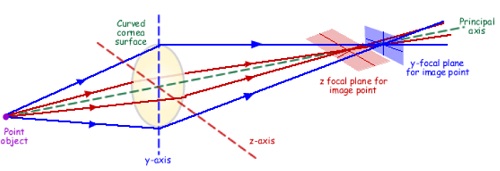
This defect can be corrected by using cylindrical lenses. The cylindrical lenses are designed in such a way so as to compensate for the irregularities in the curvature of cornea.
It can be often corrected by glasses with a lens that has different radii of curvature in different planes - cylindrical lenses, contact lenses, or refractive surgery. The prescription for the cylindrical lens will be a focal length and the angle of orientation of the plane that the prescription has to be applied to. The prescription for the cylindrical and spherical lens is given on the one sheet of paper.
